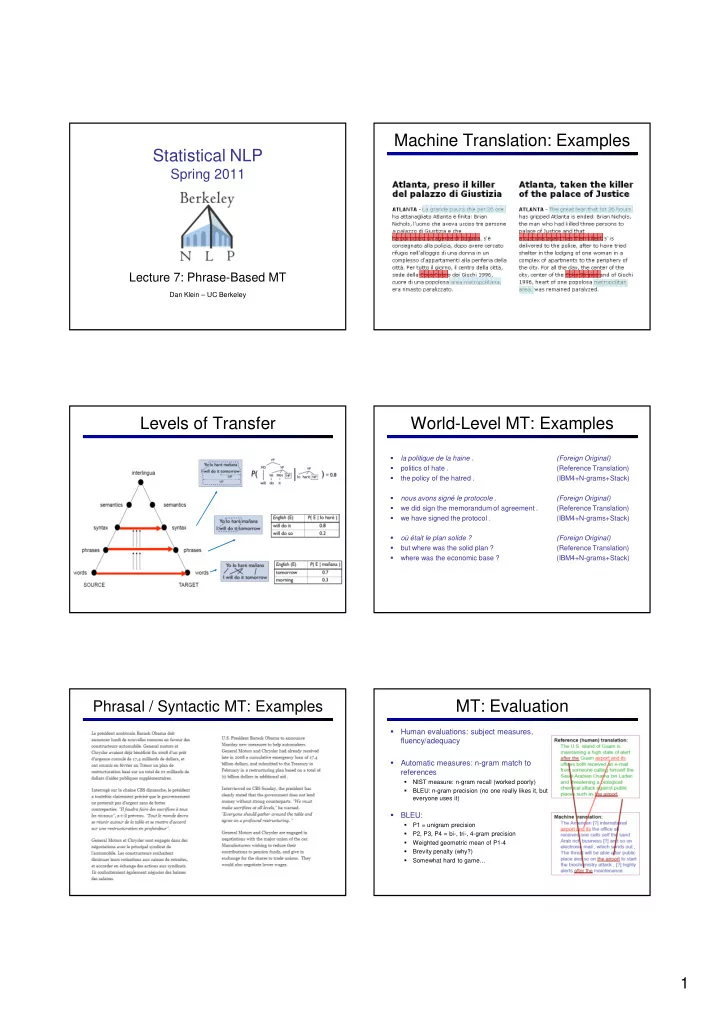

Machine Translation: Examples Statistical NLP Spring 2011 Lecture 7: Phrase-Based MT Dan Klein – UC Berkeley Levels of Transfer World-Level MT: Examples � la politique de la haine . (Foreign Original) � politics of hate . (Reference Translation) � the policy of the hatred . (IBM4+N-grams+Stack) � nous avons signé le protocole . (Foreign Original) � we did sign the memorandum of agreement . (Reference Translation) � we have signed the protocol . (IBM4+N-grams+Stack) � où était le plan solide ? (Foreign Original) � but where was the solid plan ? (Reference Translation) � where was the economic base ? (IBM4+N-grams+Stack) MT: Evaluation Phrasal / Syntactic MT: Examples � Human evaluations: subject measures, fluency/adequacy � Automatic measures: n-gram match to references � NIST measure: n-gram recall (worked poorly) � BLEU: n-gram precision (no one really likes it, but everyone uses it) � BLEU: � P1 = unigram precision � P2, P3, P4 = bi-, tri-, 4-gram precision � Weighted geometric mean of P1-4 � Brevity penalty (why?) � Somewhat hard to game… 1
Automatic Metrics Work (?) Corpus-Based MT Modeling correspondences between languages Sentence-aligned parallel corpus: Yo lo haré mañana Hasta pronto Hasta pronto I will do it tomorrow See you soon See you around Machine translation system: Model of Yo lo haré pronto I will do it soon translation I will do it around See you tomorrow Phrase-Based Systems cat ||| chat ||| 0.9 the cat ||| le chat ||| 0.8 dog ||| chien ||| 0.8 house ||| maison ||| 0.6 my house ||| ma maison ||| 0.9 language ||| langue ||| 0.9 … Phrase table Sentence-aligned Word alignments (translation model) corpus Many slides and examples from Philipp Koehn or John DeNero Phrase-Based Decoding The Pharaoh “Model” 这 7 人 中包括 来自 法国 和 俄罗斯 的 宇航 员 . [Koehn et al, 2003] Segmentation Translation Distortion Decoder design is important: [Koehn et al. 03] 2
The Pharaoh “Model” Phrase Weights Where do we get these counts? Phrase-Based Decoding Monotonic Word Translation � Cost is LM * TM � It’s an HMM? […. slap to, 6] � P(e|e -1 ,e -2 ) 0.00000016 � P(f|e) […. a slap, 5] � State includes 0.00001 � Exposed English […. slap by, 6] 0.00000001 � Position in foreign � Dynamic program loop? for (fPosition in 1…|f|) for (eContext in allEContexts) for (eOption in translations[fPosition]) score = scores[fPosition-1][eContext] * LM(eContext+eOption) * TM(eOption, fWord[fPosition]) scores[fPosition][eContext[2]+eOption] = max score Beam Decoding Phrase Translation � For real MT models, this kind of dynamic program is a disaster (why?) � Standard solution is beam search: for each position, keep track of only the best k hypotheses for (fPosition in 1…|f|) for (eContext in bestEContexts[fPosition]) for (eOption in translations[fPosition]) � If monotonic, almost an HMM; technically a semi-HMM score = scores[fPosition-1][eContext] * LM(eContext+eOption) * TM(eOption, fWord[fPosition]) bestEContexts.maybeAdd(eContext[2]+eOption, score) for (fPosition in 1…|f|) for (lastPosition < fPosition) � Still pretty slow… why? for (eContext in eContexts) � Useful trick: cube pruning (Chiang 2005) for (eOption in translations[fPosition]) … combine hypothesis for (lastPosition ending in eContext) with eOption � If distortion… now what? Example from David Chiang 3
Non-Monotonic Phrasal MT Pruning: Beams + Forward Costs � Problem: easy partial analyses are cheaper � Solution 1: use beams per foreign subset � Solution 2: estimate forward costs (A*-like) The Pharaoh Decoder Hypotheis Lattices Word Alignment Word Alignment ��� � � ������ �� ��� ���� ���������� ������������������������ ��� ������������ ������������������������ ��� �� ����������� ����������������������� ����� ���� ���� �� ��� ����������� ����������������������� ����� ����� ������ �������������������������� ������ ��� ������������������������� ���� ����������� ����������� ���� ��� �������� ���� � ������ � 4
Unsupervised Word Alignment 1-to-Many Alignments Input: a bitext : pairs of translated sentences � nous acceptons votre opinion . we accept your view . Output: alignments : pairs of � translated words � When words have unique sources, can represent as a (forward) alignment function a from French to English positions Many-to-Many Alignments IBM Model 1 (Brown 93) � Alignments: a hidden vector called an alignment specifies which English source is responsible for each French target word. IBM Models 1/2 1 2 3 4 5 6 7 8 9 E : Thank you , I shall do so gladly . A : 1 3 7 6 8 8 8 8 9 F : Gracias , lo haré de muy buen grado . Model Parameters Emissions: P( F 1 = Gracias | E A1 = Thank ) Transitions : P( A 2 = 3) 5
Recommend
More recommend